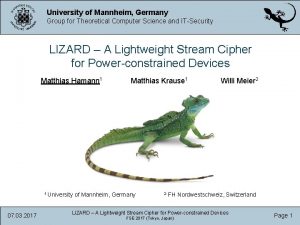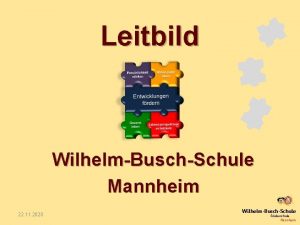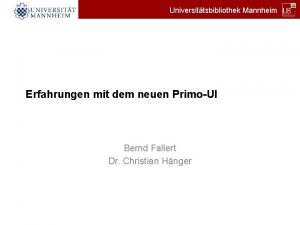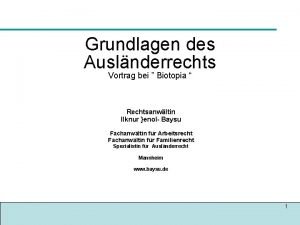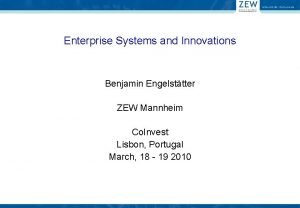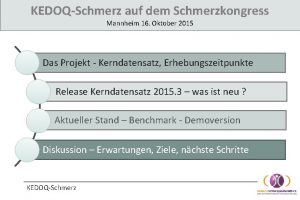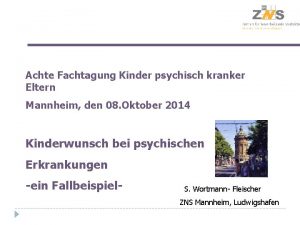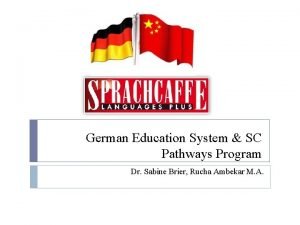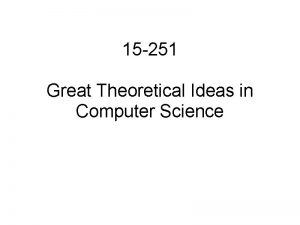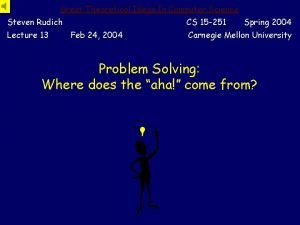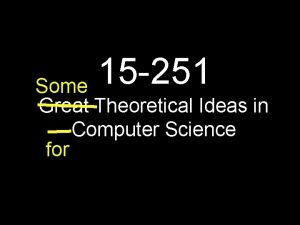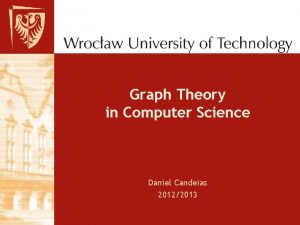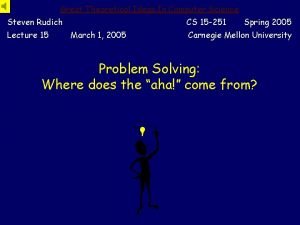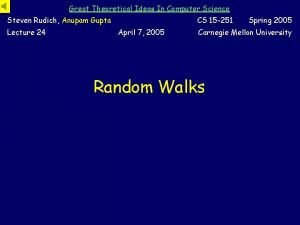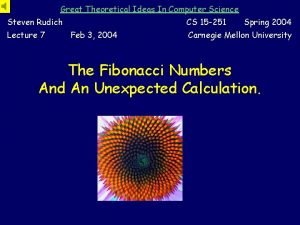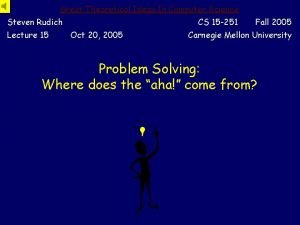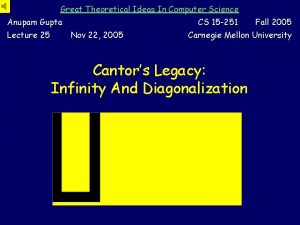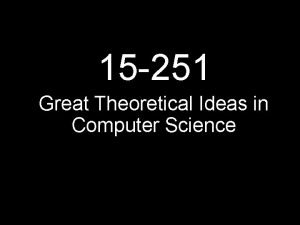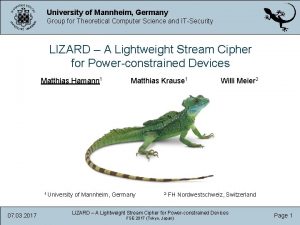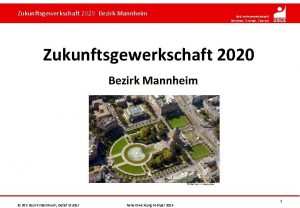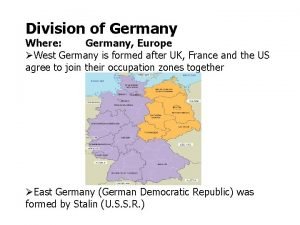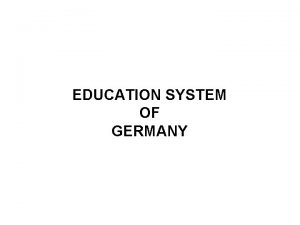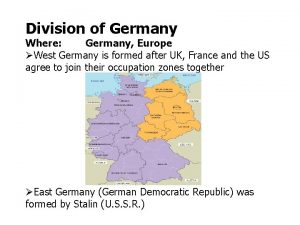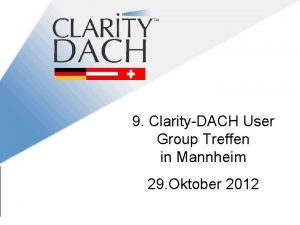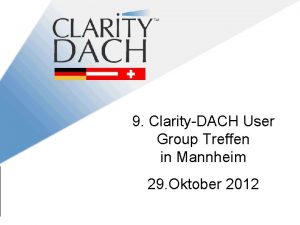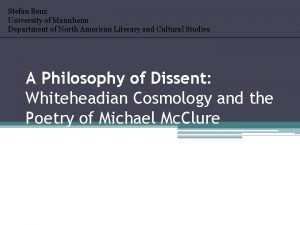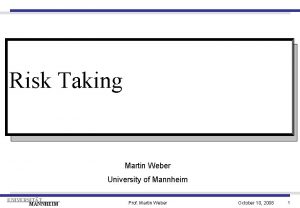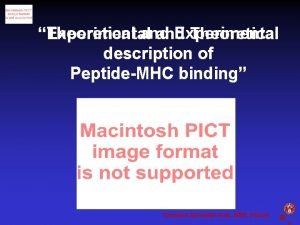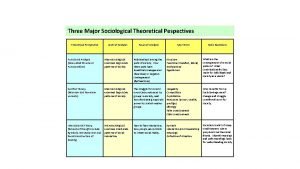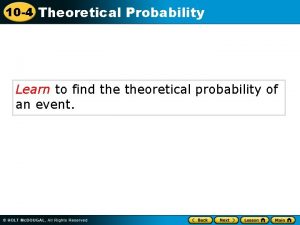University of Mannheim Germany Group for Theoretical Computer

























- Slides: 25

University of Mannheim, Germany Group for Theoretical Computer Science and IT-Security LIZARD – A Lightweight Stream Cipher for Power-constrained Devices Matthias Hamann 1 Matthias Krause 1 1 University of Mannheim, Germany 07. 03. 2017 Willi Meier 2 2 FH Nordwestschweiz, Switzerland LIZARD – A Lightweight Stream Cipher for Power-constrained Devices FSE 2017 (Tokyo, Japan) Page 1

University of Mannheim, Germany Group for Theoretical Computer Science and IT-Security Overview • Lightweight Cryptography • Traditional Stream Cipher Design • Towards Stream Ciphers with Smaller States • Sprout-like Approaches • LIZARD – Basic Properties and Difference to Grain v 1 – Components (FSRs and Output Function) – State Initialization Algorithm – Hardware • Conclusion 07. 03. 2017 LIZARD – A Lightweight Stream Cipher for Power-constrained Devices FSE 2017 (Tokyo, Japan) Page 2

University of Mannheim, Germany Group for Theoretical Computer Science and IT-Security “Lightweight!” – Well, opinions differ… 07. 03. 2017 LIZARD – A Lightweight Stream Cipher for Power-constrained Devices FSE 2017 (Tokyo, Japan) Page 3

University of Mannheim, Germany Group for Theoretical Computer Science and IT-Security Ultra-constrained RFID Hardware • Targeted Platform: Passively powered, low-cost RFID tags in the range of $0. 05 to $0. 10 like Electronic Product Codes (EPCs). • Technology: Application-specific Integrated Circuits (ASICs) - Integrated circuit customized for a particular use, rather than intended for general-purpose use. - Typical component in the low-cost RFID context, e. g. , due to low perunit costs (for large batches). • Implementation: Hardware Description Languages like Verilog. 07. 03. 2017 LIZARD – A Lightweight Stream Cipher for Power-constrained Devices FSE 2017 (Tokyo, Japan) Page 4

University of Mannheim, Germany Group for Theoretical Computer Science and IT-Security Hardware Constraints Resource / Property Limit Sources (i. a. ) Area (Security Budged) ~ 2, 000 GE [4], [12], [13], [8], [5], [9], [2], [1] Non-volatile Memory ~ 2, 048 bit [1], [6], [4] Power Clock Speed ~ 10 µW [10], [4], [12], [11] ~ 100 k. Hz [3], [7], [14], [15] More details: Lightweight Authentication Protocols on Ultra-Constrained RFIDs Myths and Facts; Armknecht, Hamann, Mikhalev; RFIDSec 2014. – List of practical limits on ultra-constrained low-cost RFID tags. – Sources: Literature, discussions with experts from industry and academia. 07. 03. 2017 LIZARD – A Lightweight Stream Cipher for Power-constrained Devices FSE 2017 (Tokyo, Japan) Page 5

University of Mannheim, Germany Group for Theoretical Computer Science and IT-Security Traditional Stream Cipher Design • Rule: State at least twice the key size (or security parameter). • Reason: Time-Memory-Data tradeoff (TMD TO) attacks based on birthday paradox. • Applies mainly if state update function is key independent. • e. STREAM finalist stream ciphers obey this rule and have keyindependent update functions. • Birthday-based distinguishers on keystream? • Can work even for key-dependent update: A Note on Distinguishing Attacks; Englund, Hell, Johansson; IEEE Information Theory for Wireless Networks, 2007. 03. 2017 LIZARD – A Lightweight Stream Cipher for Power-constrained Devices FSE 2017 (Tokyo, Japan) Page 6

University of Mannheim, Germany Group for Theoretical Computer Science and IT-Security Towards Stream Ciphers with Small State • Argue: Allow distinguisher of keystream to some extent. (Block ciphers, e. g. , in CTR or OFB, have birthday distinguishers as well. ) • Goals: – Lower area and power consumption than for existing designs. – Understanding security achievable by stream ciphers with small state. – Identify additional aspects in which existing stream ciphers may have been overdesigned for many practical applications (e. g. , keystream lengths) in the past and which may allow for smaller states. 07. 03. 2017 LIZARD – A Lightweight Stream Cipher for Power-constrained Devices FSE 2017 (Tokyo, Japan) Page 7

University of Mannheim, Germany Group for Theoretical Computer Science and IT-Security Starting Point: Grain v 1 • Member of final e. STREAM hardware portfolio. • State size 160 bit, key size 80 bit, IV size 64 bit. 07. 03. 2017 LIZARD – A Lightweight Stream Cipher for Power-constrained Devices FSE 2017 (Tokyo, Japan) Page 8

University of Mannheim, Germany Group for Theoretical Computer Science and IT-Security Stream Ciphers with Small State • For 80 bit security, can we go lower than 160 bit state size? • One idea: Make state update key-dependent. • Cannot prevent distinguishers of keystream, but possibly key recovery. (However, no corresponding proofs against TMD TO, yet. ) • Sprout: State size only 80 bit. Modelled on stream cipher Grain v 1. But has been broken by several methods. • Fruit (on e. Print): A tweak of Sprout, which needs to access several non-sequential bits of the secret key per clock cycle (speed & power impact!). • Plantlet: See FSE 2017 talk by Vasily Mikhalev. 07. 03. 2017 LIZARD – A Lightweight Stream Cipher for Power-constrained Devices FSE 2017 (Tokyo, Japan) Page 9

University of Mannheim, Germany Group for Theoretical Computer Science and IT-Security Our Approach: LIZARD 07. 03. 2017 LIZARD – A Lightweight Stream Cipher for Power-constrained Devices FSE 2017 (Tokyo, Japan) Page 10

University of Mannheim, Germany Group for Theoretical Computer Science and IT-Security of LIZARD against TMD TO 07. 03. 2017 LIZARD – A Lightweight Stream Cipher for Power-constrained Devices FSE 2017 (Tokyo, Japan) Page 11

University of Mannheim, Germany Group for Theoretical Computer Science and IT-Security Packet Mode 07. 03. 2017 LIZARD – A Lightweight Stream Cipher for Power-constrained Devices FSE 2017 (Tokyo, Japan) Page 12

University of Mannheim, Germany Group for Theoretical Computer Science and IT-Security Difference to Grain v 1 • Smaller state size: 121 bit (compared to 160 bit). • Larger key size: 120 bit (rather than 80 bit), necessary assumption for security proof. • Key is introduced not only once, but twice in initialization. • Quite different output function: Inspired by FLIP stream cipher, uses many (53) inputs. • Both register feedbacks now nonlinear. • Efficiently parallelizable up to a factor of 6 (compared to 16). 07. 03. 2017 LIZARD – A Lightweight Stream Cipher for Power-constrained Devices FSE 2017 (Tokyo, Japan) Page 13

University of Mannheim, Germany Group for Theoretical Computer Science and IT-Security LIZARD in keystream generation mode 07. 03. 2017 LIZARD – A Lightweight Stream Cipher for Power-constrained Devices FSE 2017 (Tokyo, Japan) Page 14

University of Mannheim, Germany Group for Theoretical Computer Science and IT-Security • Depends on 53 inputs, shared carefully between NFSR 1 and NFSR 2. • If NFSR 1 (the smaller FSR) assumed to be known, the remaining output function satisfies cryptographic properties well. • In particular, remaining function still nonlinear. • In contrast to Grain v 1, where the output function becomes linear in NFSR state bits if LFSR state assumed to be known. • As in FLIP, output function is a sum of linear, quadratic and triangular functions. • Fulfills the known design criteria for output function of a stream cipher. • Tap selection based on concept of full positive difference sets. 07. 03. 2017 LIZARD – A Lightweight Stream Cipher for Power-constrained Devices FSE 2017 (Tokyo, Japan) Page 15

University of Mannheim, Germany Group for Theoretical Computer Science and IT-Security LIZARD’S State Initialization 07. 03. 2017 LIZARD – A Lightweight Stream Cipher for Power-constrained Devices FSE 2017 (Tokyo, Japan) Page 16

University of Mannheim, Germany Group for Theoretical Computer Science and IT-Security LIZARD’S State Initialization – Phase 2: Grain-like mixing (128 clock cycles) 07. 03. 2017 LIZARD – A Lightweight Stream Cipher for Power-constrained Devices FSE 2017 (Tokyo, Japan) Page 17

University of Mannheim, Germany Group for Theoretical Computer Science and IT-Security LIZARD’S State Initialization – Phase 3: Second key addition (same key as in Phase 1) – Phase 4: Final diffusion (128 clock cycles, no output produced) 07. 03. 2017 LIZARD – A Lightweight Stream Cipher for Power-constrained Devices FSE 2017 (Tokyo, Japan) Page 18

University of Mannheim, Germany Group for Theoretical Computer Science and IT-Security Hardware Results • Clock speed of 100 k. Hz. • * indicates serialized key/IV loading. • Load/Ini: Number of clock cycles needed to perform the state initialization. • After state initialization, all designs produce one keystream bit per clock cycle (i. e. , 100 kbit/s). 07. 03. 2017 LIZARD – A Lightweight Stream Cipher for Power-constrained Devices FSE 2017 (Tokyo, Japan) Page 19

University of Mannheim, Germany Group for Theoretical Computer Science and IT-Security Conclusion • 07. 03. 2017 LIZARD – A Lightweight Stream Cipher for Power-constrained Devices FSE 2017 (Tokyo, Japan) Page 20

University of Mannheim, Germany Group for Theoretical Computer Science and IT-Security References w. r. t. Hardware Constraints (1) 1. 2. 3. 4. 5. 6. 7. 8. 9. P. H. Cole and D. C. Ranasinghe: Networked RFID Systems and Lightweight Cryptography: Raising Barriers to Product Counterfeiting, 2008. M. Feldhofer, J. Wolkerstorfer, and V. Rijmen. : AES implementation on a grain of sand, 2005. M. Feldhofer, S. Dominikus, and J. Wolkerstorfer: Strong authentication for RFID systems using the AES algorithm, 2004. A. Juels and S. A. Weis: Authenticating pervasive devices with human protocols, 2005. J. Melià-Seguí, J. Garcia-Alfaro, and J. Herrera-Joancomartí: J 3 Gen: A PRNG for low-cost passive RFID, 2013. A. Nuykin, A. Kravtsov, S. Timoshin, and I. Zubov: A low cost EEPROM design for passive RFID tags, 2012. P. Peris-Lopez, J. C. Hernandez-Castro, J. M. Estevez-Tapiador, and A. Ribagorda: LAMED - a PRNG for EPC Class-1 Generation-2 RFID specification, 2009. A. Poschmann, A. Moradi, K. Khoo, C. Lim, H. Wang, and S. Ling : Side-channel resistant crypto for less than 2, 300 GE, 2011. D. C. Ranasinghe, D. W. Engels, and P. H. Cole : Low-cost RFID systems: Confronting security and privacy, 2005. 07. 03. 2017 LIZARD – A Lightweight Stream Cipher for Power-constrained Devices FSE 2017 (Tokyo, Japan) Page 21

University of Mannheim, Germany Group for Theoretical Computer Science and IT-Security References w. r. t. Hardware Constraints (2) 10. 11. 12. 13. 14. 15. C. A. Repec: Regulatory status for using RFID in the EPC Gen 2 band (860 to 960 MHz) of the UHF spectrum, 2013. C. Rolfes, A. Poschmann, G. Leander, and C. Paar: Ultralightweight implementations for smart devices - security for 1000 gate equivalents, 2008. M. -J. O. Saarinen and D. W. Engels: A do-it-all-cipher for RFID: Design requirements (extended abstract), 2012. W. Wu and L. Zhang: LBlock: A lightweight block cipher, 2011. M. Feldhofer: Comparison of Low-Power Implementations of Trivium and Grain, 2007. T. Good and M. Benaissa: Hardware performance of e. Stream phase-III stream cipher candidates, 2008. 07. 03. 2017 LIZARD – A Lightweight Stream Cipher for Power-constrained Devices FSE 2017 (Tokyo, Japan) Page 22

University of Mannheim, Germany Group for Theoretical Computer Science and IT-Security Thank you for your attention! 07. 03. 2017 LIZARD – A Lightweight Stream Cipher for Power-constrained Devices FSE 2017 (Tokyo, Japan) Page 23

University of Mannheim, Germany Group for Theoretical Computer Science and IT-Security Appendix: Hardware Constraints (1) 1. Area: – Measured in Gate Equivalents (GE): 1 GE = area of a two-input NAND gate. – Common implementation tradeoff: Area vs. speed (serial/roundbased/parallel). – Limit: ~ 2, 000 GE (security budget). – (AES ~ 3, 400 GE, SKINNY-64 -128 ~ 1, 696 GE, Grain v 1 ~ 1250 GE. ) 2. Non-volatile Memory (NVM): – – 07. 03. 2017 Volatile memory limits included in area constraints (e. g. , for flip-flops). Prevalent technology: EEPROMs (costly in terms of speed and power). Alternatives w. r. t. key storage: Masks, fuses. Limit: ~ 2, 048 bit. LIZARD – A Lightweight Stream Cipher for Power-constrained Devices FSE 2017 (Tokyo, Japan) Page 24

University of Mannheim, Germany Group for Theoretical Computer Science and IT-Security Appendix: Hardware Constraints (2) 3. Power: – (Low-cost / Ultra-constrained) Tags are passively powered. – Limiting factors: Transmission power of RFID readers (e. g. , due to legal regulations), temperature issues in medicine (Δ < 1 °C), … – Numbers strongly depend on the technology library. – Limit: ~ 10 µW. 4. Clock Speed: – Limited esp. by power constraints. – Important w. r. t. transmission (encryption/decryption) times. – Limit: ~ 100 KHz. 07. 03. 2017 LIZARD – A Lightweight Stream Cipher for Power-constrained Devices FSE 2017 (Tokyo, Japan) Page 25
 Mannheim computer
Mannheim computer Wilhelm-busch-schule mannheim
Wilhelm-busch-schule mannheim Solar flachdachanlage mannheim
Solar flachdachanlage mannheim Ub mannheim primo
Ub mannheim primo Leonardo musso mannheim
Leonardo musso mannheim Biotopia mannheim stellenangebote
Biotopia mannheim stellenangebote Enterprise mannheim
Enterprise mannheim Alexandra niessen-ruenzi
Alexandra niessen-ruenzi Schmerzkongress mannheim
Schmerzkongress mannheim Zns mannheim
Zns mannheim Sabine brier
Sabine brier Brown and clough theory on group living
Brown and clough theory on group living Great theoretical ideas in computer science
Great theoretical ideas in computer science Great ideas in theoretical computer science
Great ideas in theoretical computer science Great theoretical ideas in computer science
Great theoretical ideas in computer science Graph computer science
Graph computer science 15 251
15 251 Great theoretical ideas in computer science
Great theoretical ideas in computer science Great theoretical ideas in computer science
Great theoretical ideas in computer science Steven rudich
Steven rudich Vocabularize
Vocabularize Great theoretical ideas in computer science
Great theoretical ideas in computer science Great theoretical ideas in computer science
Great theoretical ideas in computer science Formuö
Formuö Novell typiska drag
Novell typiska drag Tack för att ni lyssnade bild
Tack för att ni lyssnade bild
